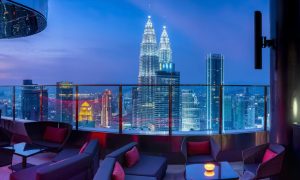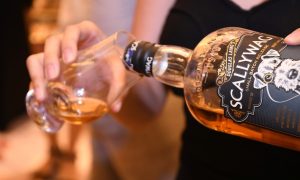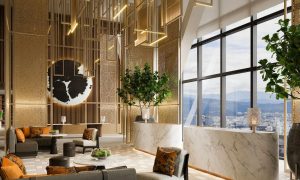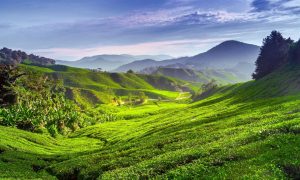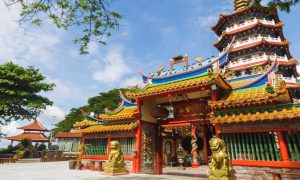[img_gallery][/img_gallery]
Head to Langkawi and join Louise Molyneux as she enjoys a leisurely boat ride through the beautiful mangrove forest of the Kilim Geoforest Park, one of the island’s top tourist attractions.
Its chestnut brown feathers gleam in the sunlight as the Brahminy Kite swoops down to the smooth, jade green river in search of fish. We are sitting in silence on our small wooden motorboat in the midst of the mangroves of the Kilim Geoforest Park watching a nature show unfold before our eyes. Eleven kites effortlessly soar in the cloudless sky then dive towards the water, returning to the air in a seamless loop, as if pulled around by a hand on an invisible string.
See Also: Langkawi As A Geopark: What Does This Mean?
One of three UNESCO (United Nations Educational, Scientific, and Cultural Organisation) designated Geopark areas in Langkawi, the Kilim Karst Geoforest covers an area of 2,415 hectares and contains some of the most spectacular mangroves in Malaysia, set as they are against 550-million-year old limestone cliffs (give or take an eon or two). These massive, dark, rocky outcrops tower above the verdant forest, sculpted into magnificent shapes by the sea and tropical rain in the millennia since they were uplifted from the ocean floor. Karsts are fossilized coral reefs from another age, not dissimilar to those forming out in the sea today. The steep cliff faces exhibit the edges of the reef. The space in between was once occupied by more easily eroded mud, now long gone. This inspiring scenery extends northwards, limestone islands appearing on the horizon as “bunny ears” and “caterpillar islands” to my 5-year-old’s eyes.
A Park For The Earth
A Geopark is a defined area containing internationally significant, geologically important sites. Its purpose is to conserve the geological heritage and promote public awareness of it through environmentally friendly tourism. Langkawi’s status as a Geopark is an often overlooked by tourists in favour of its beautiful beaches and duty-free shopping but, to my mind at least, it is its most endearing quality. Designated in 2007, the island is home to Southeast Asia’s first Geopark, which comprises three distinct areas in the Langkawi cluster of islands: the Kilim Karst Geoforest in the northeast of the main island, the Machinchang Cambrian Geoforest in the northwest and the Dayang Bunting Marble Geoforest on an island just south of the main island.
Choosing to explore the oldest of the parks, we took a two-hour boat trip from Kilim Jetty on the river of the same name. It was high tide, the river almost hiding the roots of the trees so that in places they seemed to be floating alongside us, the banks unseen through the impenetrable mass of thick, green Rhizophora leaves.
Into The Mangroves
A cursory glance suggests the outlook is all green but Daia, our guide, points out one yellow leaf in each family of leaves. Suddenly I can see them everywhere, shining like golden baubles hanging on a Christmas tree. These are the so-called “sacrificial” leaves – the one in each clump that collects all the saline, enabling the rest of the plant to survive in this brackish environment. Eventually this thick yellow leaf that tastes of salt falls off, the next lowest leaf taking its place as new, thinner, green leaves sprout from the top of the bunch.
Also hanging from the trees are long, green seedpods. When these detach from the tree they either land vertically in the mud below, get stuck and take root or they float away until they are trapped and take root elsewhere, so enlarging the forest.
I remark on the relatively pristine nature of the park, for indeed it is unusual and refreshing not to see plastic bags or bottles littering the riverside. Daia explains the role of the mangrove forest as a water filter: the tangled web of thick roots trap rubbish in the river as it flows out to sea and rubbish from the sea that is washed in at high tide. Every few days a team of local people journey along the mangroves and pick out the rubbish. We must be there soon after a clean-up. Apparently, the mangroves also played an important role during the 2004 tsunami, absorbing the destructive power of the wave and protecting the area inland.
A Haven For Life
As our boat motors along, we spot movement in the trees: a troupe of long-tailed macaques jumping between the branches looking for fruit. Then they spot us and their attention shifts to what we might have as one shamelessly pounces onto the roof of a neighbouring boat. These are the “cheeky monkeys” we saw on our Rainforest Awakening walk early the previous morning – the ones that climb through hotel windows and raid the minibar!
Daia tells us that the Kilim Karst Mangroves are home to fiddler crabs and monitor lizards, as well, but the only other wildlife we see is the fish in the farm next to “The Hole in the Wall” café. This incongruous outfit amongst a long line of yachts from as far away as Europe and Australia (moored here because it is the cheapest place on the island) is essentially a series of nets suspended between boardwalks housing a choice of fish you can pick out and have prepared for lunch, along with eels and enormous stingrays that come up to the surface to be petted. We take a cursory look at them and sit down for a cold drink, a welcome break from the tropical sun.
From here, our journey continues out from the Kilim River into the open sea. As we reach the ocean, the geoforest’s “Hollywood sign” jumps out from the cliff and the boat driver slows for the obligatory photo shoot. Memories captured, we continue zipping along, the wind in our hair, the majestic, jungle-clad, limestone peaks of the northern coastline of the island unfolding on the left and Thailand appearing on the horizon on the right. The Andaman Sea glistens blue and green in the sunlight, deserted beaches showcase white sand… Malaysia is looking its best for us.
We make a brief stop at some caves to look for bats and at the impressive stalactites that reach down from the ceiling towards the sea, but all too soon our time is up and we are soon back and mooring at the jetty. Perhaps we should have opted for a longer cruise – the board at the ticket desk displays lengthier options – but I can’t help feeling the end would always come too soon.
Source: Senses of Malaysia May/June 2014
Read More Articles on Langkawi:
- Five Beaches in Langkawi You Should Know
- Penang or Langkawi, Which to Visit?
- Langkawi’s Hidden Waterfalls
What are your thoughts on this article? Let us know by commenting below.No registration needed.



